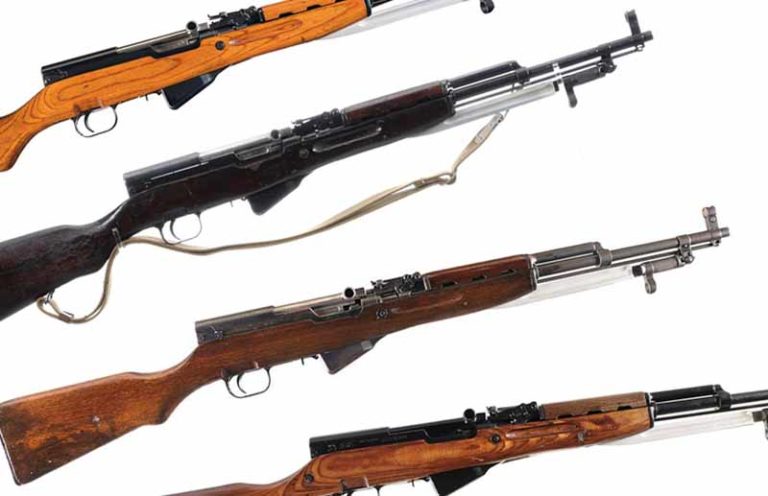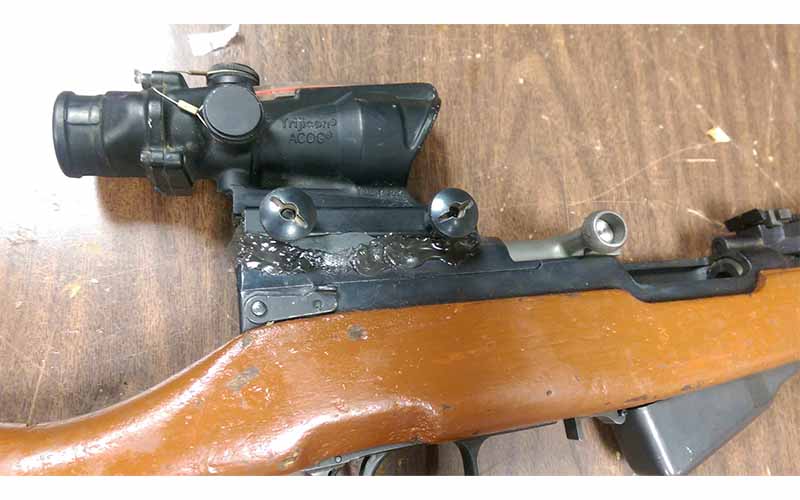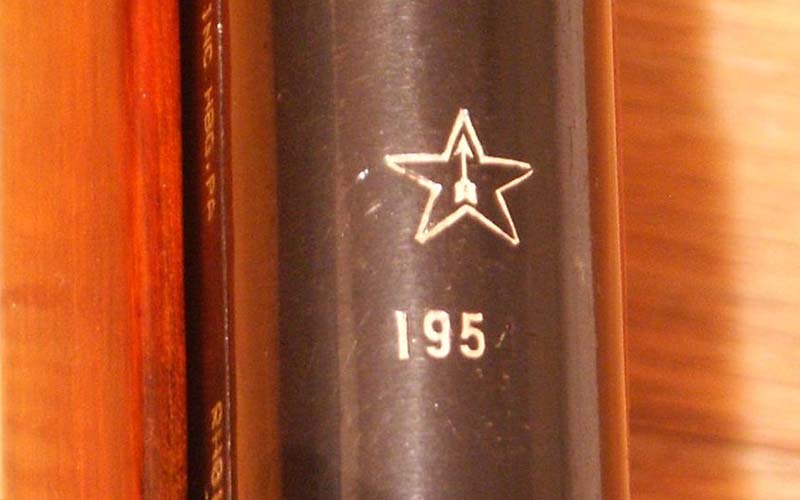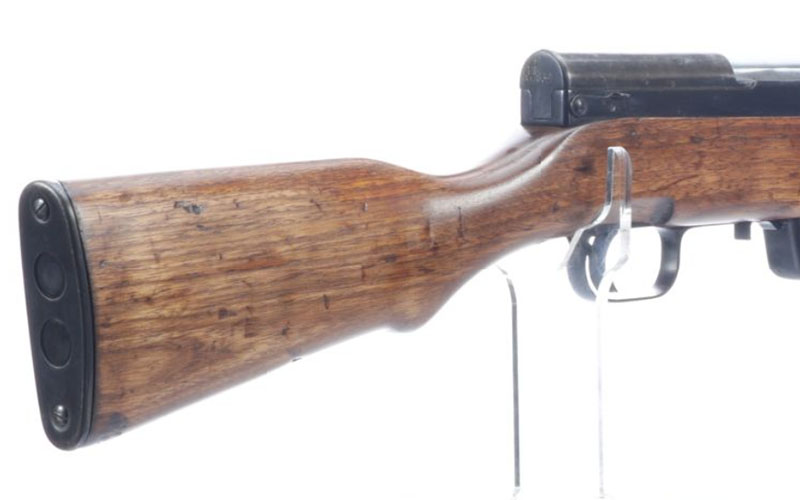
With so many different kinds imported over the years, it can be difficult to know what kind of SKS you’re looking at, this guide will help you identify all manner of Simonov carbines and roughly estimate their value.
There was a time when an SKS could be had for around $100. Regardless of the specific make or model, the sheer abundance of these rifles and the circumstances under which they were imported made them Fudd fodder. Their extremely low prices caused many Americans to view them as poorly made garbage guns not worthy of respect, leading some to victimize them with amateur gunsmithing projects that resulted in poorly welded-on scope rails, home-modified stocks and distasteful rattle can jobs. You can still find abominations like this at just about any gun show, usually sitting in front of someone who says things like “I know what I got.”

Irrespective of the confidence with which they assert such claims, individuals like this typically do not know what they got. To be fair, identifying and appraising an SKS is not always the easiest of tasks, but it is very doable if you know what to look for. This guide will show the easiest ways to determine an SKS’ country of origin and what you should generally expect to pay for one in the current market.
SKS Import History
The first SKS carbines to come into the U.S. were brought back by veterans during the Vietnam War as trophies. For several years these were the only ones that could be found in the country. With ammunition for them being both rare and expensive, they were far more collector’s items with interesting historical provenance than they were shooters. In the 1980s, however, that began to change. As relations between the U.S. and China improved they began to take advantage of Americans’ love of cheap, reliable firearms. Literally, millions of SKSs (along with plenty of cheap 7.62×39 to feed them) were imported from China between the mid to late ‘80s and 1994 when President Clinton signed the Norinco Ban, making them the most abundant SKS variant in the United States by far.

The end of Chinese imports was conveniently timed with the fall of the USSR, however, resulting in the newly formed Russian Federation satisfying SKS demand until it too was cut in 1998. Most of the Russian SKS examples in the United States were imported during these four years (as well as several other classic Soviet military surplus firearms). While not nearly as abundant as Chinese models, a healthy number of Russian guns were brought in as well.
Following the cutoff of imports from Russia, SKSs from other nations began to fill the void. Yugoslavian models began to come in along with Romanian and Albanian guns. While these were also very affordable at the time, they never reached the same levels of abundance or inexpensiveness as the Chinese guns.

As with all surplus firearms, SKS stockpiles eventually began to run dry across the world. While China, Russia and a few other nations still likely have warehouses full of the things, U.S. law prevents any new batches from being imported from these countries. With relatively few remaining SKSs around the globe that can legally be brought into the U.S., prices began rising as soon as availability went down. While there are still plenty of places in the world where an SKS could be had for a goat or a few chickens, in America, they have unfortunately garnered “collector” status and are no longer the dime-a-dozen truck guns they once were.
Some SKS variants are easier to tell apart than others, and even some minor differences between models and years can have a big impact on their value. So, let’s take a look at the different kinds of SKS that you’re likely to encounter on the American second-hand gun market, how to identify them, and what they’re generally worth. The good news is that regardless of the exact model you end up getting, they were all very well made. Some are more valuable or collectible than others, but when it comes to actually shooting the things, they will all serve you equally well.
SKS Variants
This list will cover the major differences between SKS variants, but it is not exhaustive. Differences between factory markings, years of production and the manufacturing methods of specific individual components can all result in an SKS being worth more than average, but those details are only important to serious collectors. There are plenty of online forums where people discuss these things, and that’s where you should go if you’re looking how to tell an early-style trigger guard from a late-style, or other equally pedantic details. For an introduction to more surface-level SKS analysis, however, read on.
Russian SKS

The original, upon which everything that came after was based. The acronym in English reads as Samozaryadny Karabin sistemy Simonova, 1945, or Self-loading Carbine of Simonov, 1945. It was developed alongside the new M43 cartridge in the final years of WWII, even supposedly having a few early-production models seeing field trials in Belarus and Berlin before the European theater finally came to an end. They were produced at both the Tula (arrow in star factory symbol) and Izhevsk (arrow in triangle in circle factory symbol) and depending on the year of production they could have either hardwood or laminate stocks. Tula produced far more over the years, making them the more common and less desirable of the two factories. The earliest Russian SKSs used a cruciform bayonet like the ones found on M44 Mosins, but they quickly switched to a blade style. Many Russian SKSs underwent factory refurbishment before being imported as well, and it results in some examples having non-original features like a blued bolt and/or bayonet which were originally left in the white.

An SKS carbine from its country of origin is obviously more collectible than any other common Simonov variety, so they command some of the highest prices on the second-hand market. Early models, Izhevsk-produced models and very nice condition examples easily sell for a grand or more these days. Some even fetch as much as two thousand dollars in online auctions. A far cry from the prices of the ‘90s, but there is a finite supply of Russian SKS carbines in the country and their collectability has driven up both their demand and value. These days, unless you specifically want an SKS made in its country of inception, Russian models probably aren’t what to look for. Examples from other countries can be found for lower prices and will shoot just as well, so at this point, it's best to leave Russian SKSs to the collectors if you’re only looking for a range toy or ranch gun.

Chinese SKS

There exists the greatest level of variation between models when it comes to the Chinese SKS. The Chinese clearly had an affinity for this design, not only producing it in the largest numbers of any nation but for the longest duration and with the most amount of experimentation and development. China was the only nation to ever produce an SKS with a stamped receiver, and they also experimented with things like different stock materials, shorter barrel lengths and the ability to feed from AK mags. Chinese SKSs are the most common kind in the U.S. by far, but identifying the exact model can be challenging with so many slight variations. Standard commercial variants with spike bayonets are the most common, but they were manufactured by and imported from several different factories. Military surplus Type 56 models were brought in as well, along with some of the rarer commercial variants like the SKS-D or Model M which feed from AK magazines.

The majority of Chinese SKSs in the U.S. were exported by Norinco, although Polytech sent some over too. These defense conglomerates were acquiring rifles from a variety of sources for the American market, but the most common source seems to be the Jianshe Arsenal with factory code 26. Other factories in China produced the SKS as well, but all use a similar symbol to identify the factory, typically a stylized number inside of a triangle. Any logo like this on the left side of the receiver means that it’s Chinese, but identification is often made easier by the inclusion of Chinese characters or “Norinco” printed in English as well. Most, but not all, Chinese SKSs have a spike or “pig-sticker” type bayonet as well.
The most recent batches of SKS imports have been Type 56s bought from Albania, as they received many as military aid from China some years ago. While the bulk of these recent imports had very poor condition stocks and finishes, most were still serviceable and fine shooters. These were typically sold for about $400 to $450. While expensive for their condition, in today’s surplus market that seems to be as low as any dealer is willing to sell them for. What the rifles from these import batches lack in terms of prettiness, they make up for in historical provenance. They saw active service with the Albanian military and many were likely used during the Balkan civil war. Some feature “trench art”, personal decorative touches from the soldiers they were issued to, and some find that to be even cooler than having an all-matching, original-condition rifle.

Yugoslavian SKS

Like all things Yugoslavian, they did their SKS just a bit different than everyone else. Yugoslavian SKSs are one of the more common kinds in the U.S. after Chinese guns, and they’re the most distinctive and easy to identify as well. The most common Yugo SKS pattern is the Zastava M59/66 PAP which was built under license from the USSR. The most notable change they made to the design was the addition of rifle grenade-launching capabilities, resulting in a distinct grenade launcher spigot added to the end of the barrel and a gas cut-off lever/grenade sight to the gas tube. When a blank round is loaded and the gas cut-off lever is lifted, a Yugo SKS can be used to launch 22mm rifle grenades of several different varieties. Another Yugo-specific quirk is that they never chrome-lined the barrels of their SKSs. Very early Russian examples didn’t have chrome-lining either, but it was quickly added and copied by every other nation to produce the design.
Yugoslavian SKSs are typically the most affordable kind after Chinese examples, and they will usually be in better condition than what you would pay for a Type 56 of the same price.
Romanian SKS

Designated as the M56, Romanian SKSs can be some of the hardest to identify due to how similar they are to the Russian SKS it was directly copied from. Unlike Yugoslavia, whenever Romania received technical data packages from the USSR, they didn’t change much. This is why their AKM clones are some of the closest to Soviet spec as well. At first glance, a Romanian M56 will be indistinguishable from a Russian SKS, but certain markings and their location will allow you to differentiate between them. On a Russian SKS, the factory stamp can be located on the top of the dust cover, but Romanians instead put theirs on the left side of the receiver. While the Romanian Cugir factory stamp is very similar to Izhevsk’s, they are different. The Cugir “arrow in a triangle” mark is much simpler and cruder than the Izhevsk one, with the Romanian arrow looking like what one would draw to point to something rather than what is used in conjunction with a bow like the arrow on Izzy rifles.
Romanian SKSs seem to be going up in value, but they’re still not the most desirable variant out there. While they can sometimes sell for amounts that begin to approach Russian SKS prices, they can also still be found for a pretty good deal too. While not exactly “rare”, Romanian M56s are some of the less common SKSs in the country, so you may have to do some looking before you find one for sale. If you do find one, however, it would compliment a WASR or other Romanian AK very nicely.
Albanian SKS

Produced at the UM GRAMSH factory, Albanian SKSs are some of the rarest in the United States excluding the true unicorns that will be discussed below. These typically fetch a higher price than any aforementioned SKS model due to their rarity, but they still sell for relatively sane prices when compared to some other rare SKS variants. They are also very visually distinctive as well, being the only kind to change the style of the wood stock around the gas tube. The Albanians extended the handguard area to cover the full length of the gas tube, providing more real estate for the shooter’s hand but also increasing the rifle’s weight. Any SKS that has a stock that fully hides the gas tube and features three distinct, larger-than-average vent holes is undoubtedly Albanian in origin.

These can fetch a higher price when the seller is aware of what they have, but it’s also not unheard of for them to be sold at standard Chinese SKS prices. Some lucky few even got one of these rare birds out of the last Albanian batch when they thought they were purchasing a Type 56. There’s nothing especially high quality about Albanian SKSs, but they are quite unique, rare and collectible.
Rare SKS Variants
Every other country’s SKS variant not previously mentioned falls into this category, and if you even find one, expect to pay out the nose for it. These are the rarest and therefore most collectible SKS variants, at least when it comes to what can be found in the States.

This includes the East German Karabiner-S, the Polish ksS and the SKS clones made in Vietnam and North Korea. East German models are distinctive due to their K98-style sling slot in the stock, and they were only produced for two or three years. Very few were ever imported into the U.S. and most examples are Vietnam bringbacks. It seems that the majority of DDR SKSs were given as military aid to North Vietnam and later Croatia, resulting in the majority being lost in the haze of the conflicts each were involved in. Most North Korean and Vietnamese SKSs that entered the country were veteran bringbacks as well.

Poland never actually produced the SKS themselves, but they did receive some from the USSR as military aid. Most were then refurbished using Polish-made stocks, their one distinctive Polish element. These are so rare, that it's difficult to even find a good photo of one online. It’s safe to say that you won’t be coming across one of these in the wild.
Final Thoughts
While there are plenty of cases of people attempting to sell an SKS for much more than it’s worth, not every ludicrous price you see is a mistake. Like all military surplus firearms, there are small details that can cause an otherwise normal, reasonably priced SKS to be worth far more than average to the right person. Specific historical provenance such as a Vietnam bringback with papers or an extremely rare variation of a model can cause them to be worth far more than normal. Starting a serious SKS collection obviously isn’t for everyone, but that doesn’t mean you still won’t be able to pay a decent price for a good shooter.
In the current state of the market, for anyone interested in acquiring their first SKS, their best bet would be to hunt for one of the more generic Chinese models in good shape for about $400-$450. If you can do that, you’re doing well for 2022. But if you have deep pockets and an interest in collecting some of the rarer examples out there, the sky’s the limit. Happy hunting.
More On Historical Military Rifles
- The StG 44: Father Of The Modern Combat Rifle
- The Karabiner 98k: The Best Combat Bolt-Action Rifle Ever Made
- All About The Mosin Nagant
- The Gewehr 43: The Road To Germany's Garand
- Fusil Automatique Leger: Everything You Want To Know About The FN FAL
- Lee Enfield: The Right Arm Of The Empire
- The Rise And Fall Of The AR-10
- The M1 Garand: America's Original Battle Rifle

Next Step: Get your FREE Printable Target Pack
Enhance your shooting precision with our 62 MOA Targets, perfect for rifles and handguns. Crafted in collaboration with Storm Tactical for accuracy and versatility.
Subscribe to the Gun Digest email newsletter and get your downloadable target pack sent straight to your inbox. Stay updated with the latest firearms info in the industry.

![Best Concealed Carry Guns In 2025 [Field Tested] Wilson Combat EDC X9S 1](https://gundigest.com/wp-content/uploads/Wilson-Combat-EDC-X9S-1-324x160.jpg)


![Best 9mm Carbine: Affordable PCCs [Tested] Ruger Carbine Shooting](https://gundigest.com/wp-content/uploads/Ruger-Carbine-Shooting-100x70.jpg)
![Best AR-15: Top Options Available Today [Field Tested] Harrington and Richardson PSA XM177E2 feature](https://gundigest.com/wp-content/uploads/Harrington-and-Richardson-PSA-XM177E2-feature-100x70.jpg)

Trying to get estimated date of manufacture for a Chinese SKS 7.62 x 39mm with serial number 1600767 and triangle code 306
I have a Yugo SKS 59/66A. When firing a round, the bolt remains closed and the casing does not eject. What are your thoughts as to what the problem is? Dirty or corroded gas tube??? Many thanks, Mark S
I traded a 45 Kimble today for a SKS STAR ARROW
DATED 1953 It is a very interesting rifle with all of the unique markings and all original makings of a possible fit to be and I say possibly an air loom of all SKS AFTER STUDYING ALL INFO I CAN FIND on it I need a expert to help me verify this . Email me if you think you have that ability to verify we will be be amazed I promise you and the value of it may exceed by far thank you kindly
I have an SKS with the numbers matching ER 2631. Who makes and what year?